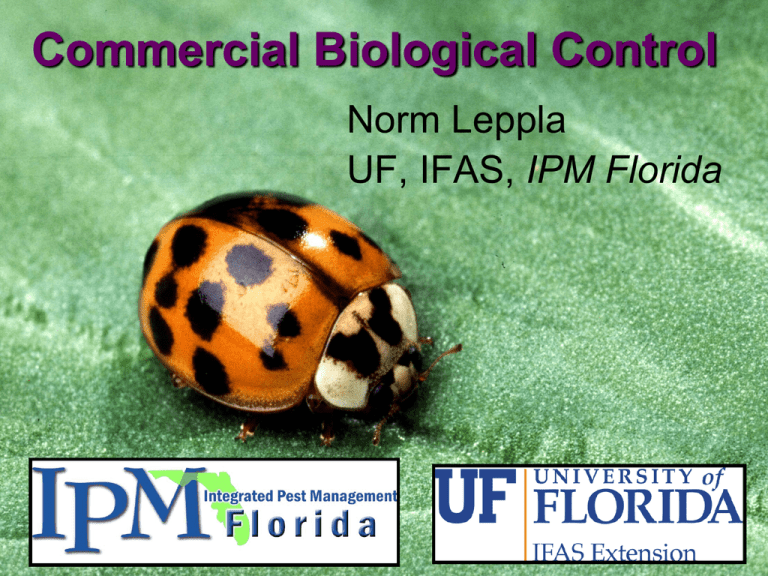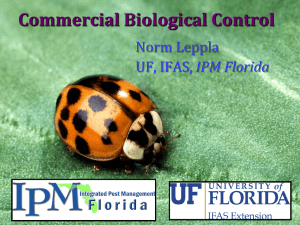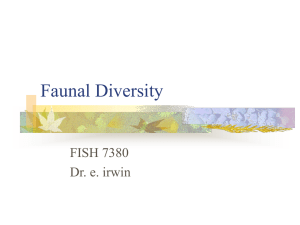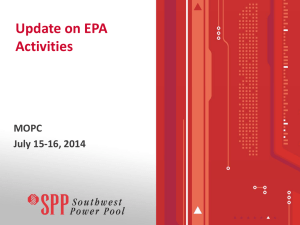Commercial Biological Control
advertisement

Commercial Biological Control Norm Leppla UF, IFAS, IPM Florida Milestones in Commercialization of Biological Control 1895- Farming Trichogramma proposed 1926- Fillmore, mass prod. NE citrus pests 1929- Trichogramma on factitious host 1949- Chrysoperla colonization 1956- Predaceous mites, mites on strawberry 1968- Koppert established 1975- Trichogramma, European corn borer 1981- IOBC WGQC (AMRQC) 1988- Whitefly parasites, Europe glasshouses 1990- ANBP established in California 1995- Commercial artificial diet for predators 1995- IBMA established in France Biological Control Organizations with Commercial Affiliations IOBC ANBP's Objectives Members of ANBP are expected to adhere to a code of ethics which encourages the highest standards in the production and marketing of natural enemies. • • • Strengthen the commercial natural enemy industry. Promote research and education on the use of natural enemies. Develop quality certification programs for natural enemies. Guidelines for Purchasing and Using Commercial Natural Enemies and Biopesticides in Florida and Other States N. C. Leppla and K. L. Johnson More than 49 biological control companies provide nematodes, mites, insects, and bioinsecticides for pest management in Florida and the Southeast. Nematodes are sold by 28 companies (5 species). Predators are sold by 31 companies, 26 supply mites (10 species) and 31 supply insects (15 species) Parasitic wasps are sold by 31 companies (23 spp.). Table 1. Habitats, pests, natural enemies and reference number Tables 2-7. Number of natural enemy products and sources Table 2- Nematodes (8) Table 3- Predatory mites (10) Table 4- Predatory insects (15) Table 5- Parasitic wasps (23) Table 6- Biopesticides (21) Table 7- Companies and websites (49) Nematodes and Mites NEMATODES Heterorhabditidae- Heterorhabditis (2 spp) Steinernematidae- Steinernema (3 spp) ARACHNIDS Laelapidae- Hypoaspis (1 spp) Phytoseiidae- Amblyseius, Galendromus, Mesoseiulus, Neoseiulus, Phytoseiulus (9 spp) Predatory Insects Coleoptera Coccinellidae- Cryptolaemus, Delphastus, Hippodmia, Rhyzobius, Stethorus Cybocephalidae- Cybocephalus Histeridae- Carcinops Staphylinidae- Dalotia (also called Atheta) Diptera Cecidomyiidae- Aphidoletes, Feltiella Hemiptera Thysanoptera Anthocoridae- Orius Thripidae- Scolothrips Pentatomidae- Podisus Neuroptera Chrysopidae- Chrysoperla Parasitic Wasps Hymenoptera Aphelinidae- Aphelinus, Aphytis, Encarsia, Eretmocerus (5 spp) Braconidae- Aphidius, Cotesia, Dacnusa (5 spp) Encyritidae- Leptomastix, Metaphycus (2 spp) Eulophidae- Diglyphus, Pediobius (2 spp) Pteromalidae- Muscidifurax, Nasonia, Splangia (6 spp) Trichogrammatidae- Trichogramma (3 spp) Major Commercial Natural Enemies Major Commercial Natural Enemies Markets for Natural Enemies Entomopathogenic nematodes- Heterorhabditis, Steinernema Predatory mites- Amblyseius, Galendromus, Neoseiulus, Phytoseiulus, Hypoaspis Predatory insects- Chrysoperla, Cryptolaemus, Hippodamia, Orius, Dalotia, Coccinella, Delphastus, Feltiella, Podisus, Rhyzobius,Stethorus Parasitoids- Aphelinus, Aphytis, Encarsia, Eretmocerus, Aphidius, Pediobius, Trichogramma Fly parasites- Muscidifurax, Splangia, Nasonia Biopesticides- Bacillus, Beauveria, Trichoderma Predators! Description of U.S Companies Serving the Southeast Number = 49 producers and suppliers Size = 10 employees average Revenue = $20-25 million, 3 > $1.5 million Species = 56 (+ 21 microbials), 5/20 producers >3 species, ca 50% produce one, few new species. Natural Enemy Sales Increases Pesticide resistance Transgenic crops Loss of pesticides (regulatory) New more selective pesticides Cost of pesticides (registration) Alien invasive species Cropping systems (pollinators, organic) IPM Transition Invasive Pest Resistant Crop • Competitors • Natural enemies Vulnerable Crop Pesticide program: • New insecticides • New formulations • New Application methods • Resistance management • Resistant varieties Integrated pest management program: • Cultural practices • Scouting, ID of pests & NEs • Conservation of NEs • Augmentation of NEs • Reduced-risk insecticides • Resistance management Requirements for Commercialization 1. 2. 3. 4. 5. 6. Research teams vs. solo Financial support for R&D Practical technology Effective against pest High benefit/cost Safe for the environment Chemical Pesticides Versus Biological Control: Investment and Return 3 Billion 3 30 Billion Investment Sales 600 Million 100 Million Biological Control Chemical Pesticides Year 20 20 19 19 19 19 19 19 19 19 19 19 19 03 00 97 94 91 88 85 82 79 76 73 70 67 Cumulative Number of Species New Product Development 35 30 25 20 15 10 5 0 Amblyseius swirskii MiteTreatm Species ent A. limonicus T. swirskii A. ovalis E. scutalis A. degenerans A. cucumeris A. barkeri E. finlandicus 1200 A. cucumeris DPV T. pyri Perdentage compared to A. cucumeris Western Flower Thrips Control in Cucumbers 1500 Predatory mites F. occidentalis larvae 900 600 300 0 Bemesia tabaci Control on Hibiscus Evolution of the population of whiteflies Bemisia tabaci Release dates 1 2 3 15 35 30 10 25 20 15 5 10 5 0 0 13 14 15 A. swirskii perofplant Mean number A. swirskii/plant B. tabaci with A. swirskii A. swirskii B. tabaci without swirskii Control without A.A. swirskii 16 17 18 week 19 20 21 22 mean number of A. swirskii /plant mean number of alive pupae of Bemisia tabaci/plant 40 Amblyseius swirskii Effectiveness Very high numerical response to availability of food Highly efficacious against western flower thrips, greenhouse whiteflies and tobacco whiteflies In combination with: • Orius spp. against western flower thrips • Whitefly parasites against whiteflies • P. persimilis or A. californicus against two-spotted spider mites Good establishment on pollen Whiteflies can substitute for pollen in peppers Good results in North and South Europe May replace A. cucumeris, depending on release permits Commercial Biological Control Needs Expertise New Markets & Products Science and Technology • • • • • Improved rearing and release methods Field tests to determine efficacy Compatibility with pesticides Taxonomic support Quality control Regulations Pesticide Side Effects Global QC Programs Individual Companies Customers International Standards ISO 9000 ASTM (Amer. Soc. for Testing & Materials) IOBC Guidelines (European Community) The Marketplace Quality Products Customer Service Many companies provide detailed information on how to use their products. The best companies deliver excellent customer service for site-specific biocontrol. The marketplace ultimately determines the usefulness of commercial natural enemies. Information on Commercial Biological Control http://ipm.ifas.ufl.edu









